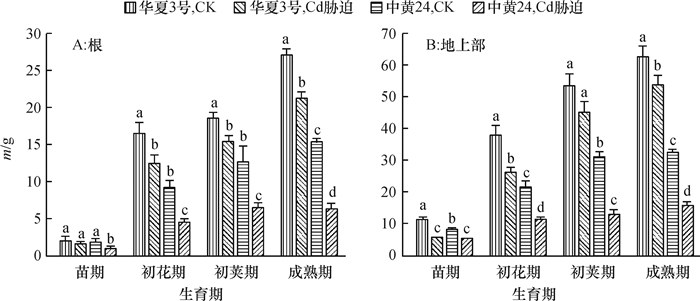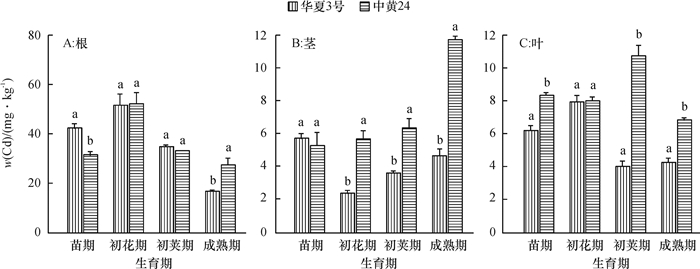Dynamic changes of cadmium and non-protein thiol in different organs of different soybean genotypes under cadmium stress
-
摘要:目的
探讨不同大豆品种各器官镉和非蛋白巯基物质的动态变化,揭示巯基物质在大豆镉抗性和积累中的作用。
方法在镉(Cd)污染的土壤中种植镉抗性和籽粒积累不同的大豆品种中黄24和华夏3号,采集不同生育时期的根、茎和叶,分析各品种的Cd抗性指标(根系和地上部鲜质量)、Cd积累指标(各器官Cd浓度)和非蛋白巯基物质[总非蛋白巯基肽(NPT)、谷胱甘肽(GSH)和植物螯合肽(PC)]的浓度变化。
结果在10 mg·kg-1的Cd胁迫下,中黄24不同时期Cd抗性指标明显低于华夏3号,而中黄24初花期后各器官Cd浓度均显著地高于华夏3号。Cd胁迫下2个品种随发育进程根系中NPT、GSH和PC浓度上升,而叶片中则下降;敏感品种中黄24各器官中巯基物质对Cd胁迫响应比抗性品种华夏3号更显著。关联分析发现,大豆根部巯基物质浓度与各器官Cd浓度呈正相关,且以成熟期最为显著,而初花期后地上部的PC与各器官Cd浓度呈负相关。
结论在大豆不同生育期不同器官中Cd和非蛋白巯基物质浓度变化复杂,非蛋白巯基物质在大豆抵抗Cd胁迫中扮演多种角色。
Abstract:ObjectiveDynamic changes of cadmium and non-protein thiols in different soybean genotypes were researched to investigate effects of non-protein thiols on Cd tolerance and accumulation of soybean.
MethodThe soybean varieties of Zhonghuang24 and Huaxia3 were planted in the pots with contaminated soil. Roots, shoots and leaves were collected in different periods. Cd tolerance indexes (including root and shoot fresh mass), Cd accumulation and the concentrations of non-protein thiols [including the total of non-protein thiol peptides (NPT), glutathione (GSH) and phytochelatins(PC)] of soybeans in different periods were determined.
ResultThe resistance indexes of Zhonghuang24 were significantly lower than those of Huaxia3 in different periods at the Cd concentration of 10 mg·kg-1, and Cd accumulations in all organs were higher than those of Huaxia3 after flowering stage (especially at pod and mature stages). The NPT, GSH and PC concentrations increased in root and reduced in leaf along with the development progress, and the effects of non-protein thiols in Zhonghuang24 under Cd stress were stronger those of Huaxia3. The correlation analysis indicated that there was a positive correlation between thiol concentration in root and the Cd concentration in all organs, especially at mature stage. There was a negative correlation between PC concentrations in stem and leaf after flowering stage, especially more significant at pod and mature stages.
ConclusionThe concentrations of thiols and Cd in soybean organs show complex changes at different growth stages under Cd stress. Non-protein thiols play multiple roles in Cd detoxification and transportation at different growth stages.
-
Keywords:
- Cd stress /
- soybean /
- non-protein thiol /
- glutathione /
- phytochelatin
-
-
表 1 大豆各器官中巯基物质与镉浓度和抗性指数的相关分析1)
Table 1 Correlation analysis of non-protein thiol and Cd contents in organs, and tolerance indexes of two soybean genotypes

-
[1] 曾希柏, 徐建明, 黄巧云, 等.中国农田重金属问题的若干思考[J].土壤学报, 2013, 50(1): 186-193. http://d.old.wanfangdata.com.cn/Periodical/trxb201301023 [2] SANITA D, TOPPI L, GABBRIELLI R. Response to cadmium in higher plants [J]. Environ Exp Bot, 1999, 41(2): 105-130. doi: 10.1016/S0098-8472(98)00058-6
[3] BENAVIDES M P, GALLEGO S M, TOMARO M L. Cadmium toxicity in plants [J]. Brazil J Plant Physiol, 2005, 17(1): 21-34. doi: 10.1590/S1677-04202005000100003
[4] LUX A, MARTHINK M, VACULIK M, et al. Root responses to cadmium in the rhizosphere: A review [J]. J Exp Bot, 2011, 62(1): 21-37. doi: 10.1093/jxb/erq281
[5] ZHAO Y, FANG X, MU Y, et al. Metal pollution (Cd, Pb, Zn, and As) in agricultural soils and soybean, Glycine max, in southern China [J]. B Environ Contam Tox, 2014, 92(4): 427-432. doi: 10.1007/s00128-014-1218-5
[6] ZHUANG P, LI Z A, ZOU B, et al. Heavy metal contamination in soil and soybean near the Dabaoshan Mine, South China [J]. Pedosphere, 2013, 23(3): 298-304. doi: 10.1016/S1002-0160(13)60019-3
[7] 赵云云, 钟彩霞, 方小龙, 等.华南地区夏播大豆品种镉耐性及籽粒镉积累的差异[J].大豆科学, 2013, 32(3): 336-340. http://d.old.wanfangdata.com.cn/Periodical/ddkx201303012 [8] 赵云云, 钟彩霞, 方小龙, 等.华南地区11个春播大豆品种抗镉性的差异[J].华南农业大学学报, 2014, 35(3): 111-113. http://xuebao.scau.edu.cn/zr/hnny_zr/ch/reader/view_abstract.aspx?flag=1&file_no=201403020&journal_id=hnny_zr [9] GRANT C A, CLARKE J M, DUGUID S, et al. Selection and breeding of plant cultivars to minimize cadmium accumulation[J]. Sci Total Environ, 2008, 390(2/3): 301-310. http://d.old.wanfangdata.com.cn/NSTLQK/NSTL_QKJJ026480049/
[10] 赵云云, 郭秀兰, 钟彩霞, 等. 大豆抗镉污染低积累育种的研究进展[J/OL]. 分子植物育种(网络版), 2011, 9: 1692-1699(2011-08-12)[2015-03-08]. http://www.biopublisher.cn/index.php/mpb/article/html/576/.DOI:10.5376/mpb.cn.2011.09.0096. [11] SHARMA S S, DIETZ K. The relationship between metal toxicity and cellular redox imbalance [J]. Trends Plant Sci, 2009, 14(1): 43-50. doi: 10.1016/j.tplants.2008.10.007
[12] CUYPERS A, KAREN S, JOS R, et al. The cellular redox state as a modulator in cadmium and copper responses in Arabidopsis thaliana seedlings [J]. J Plant Physiol, 2011, 168(4): 309-316. doi: 10.1016/j.jplph.2010.07.010
[13] LIN Y F, AARTS M G. The molecular mechanism of zinc and cadmium stress response in plants [J]. Cell Mol Life Sci, 2012, 69(19): 3187-3206. doi: 10.1007/s00018-012-1089-z
[14] SETH C S, REMANS T, KEUNEN E, et al. Phytoextraction of toxic metals: A central role for glutathione [J]. Plant Cell Environ, 2012, 35(2): 334-346. doi: 10.1111/j.1365-3040.2011.02338.x
[15] HARTLEY-WHITAKER J, AINSWORTH G, VOOIJS R, et al. Phytochelatins are involved in differential arsenate tolerance in Holcus lanatus [J]. Plant Physiol, 2001, 126(1): 299-306. doi: 10.1104/pp.126.1.299
[16] GALLEGO S M, PENA L B, BARCIA R A, et al. Unravelling cadmium toxicity and tolerance in plants: Insight into regulatory mechanisms [J]. Environ Exp Bot, 2012, 83: 33-46. doi: 10.1016/j.envexpbot.2012.04.006
[17] GUO J, DAI X, XU W, et al. Overexpressing GSH1 and AsPCS1 simultaneously increases the tolerance and accumulation of cadmium and arsenic in Arabidopsis thaliana[J]. Chemosphere, 2008, 72(7): 1020-1026. doi: 10.1016/j.chemosphere.2008.04.018
[18] SARWAR N, ISHAQ W, FARID G, et al. Zinc-cadmium interactions: Impact on wheat physiology and mineral acquisition[J]. Ecotox Environ Safe, 2015, 122: 528-536. doi: 10.1016/j.ecoenv.2015.09.011
[19] 高可辉. 镉胁迫及缺硫对水稻非蛋白巯基物质含量和谷胱甘肽硫转移酶活性的影响[D]. 南京: 南京农业大学, 2011. [20] EBBS S, LAU I, AHNER B, et al. Phytochelatin synthesis is not responsible for Cd tolerance in the Zn/Cd hyperaccumulator Thlaspi caerulescens (J. & C. Presl) [J]. Planta, 2002, 214(4): 635-640. doi: 10.1007/s004250100650
[21] LI Y, DHANKHER O P, CARREIR L, et al. Overexpression of phytochelatin synthase in Arabidopsis leads to enhanced arsenic tolerance and cadmium hypersensitivity[J]. Plant Cell Physiol, 2004, 45(12): 1787-1797. doi: 10.1093/pcp/pch202
[22] WOJAS S, CLEMENS S, HENNIG J, et al. Over expression of phytochelatin synthase in tobacco: Distinctive effects of AtPCS1 and CePCS genes on plant response to cadmium[J]. J Exp Bot, 2008, 59(8): 2205-2219. doi: 10.1093/jxb/ern092
[23] ANETOLI M, VOOIJS R, TEN BOOKUM W, et al. Arsenate tolerance in Silene paradoxa does not rely on phytochelatin-dependent sequestration[J]. Environ Pollut, 2008, 152(3): 585-591. doi: 10.1016/j.envpol.2007.07.002
[24] MAIER E A, MATTHEWS R D, MCDOWELL J A, et al. Environmental cadmium levels increase phytochelatin and glutathione in lettuce grown in a chelator-buffered nutrient solution[J]. J Environ Qual, 2003, 32(4): 1356-1364. doi: 10.2134/jeq2003.1356
[25] JOZEFCZAK M, REMANS T, VANGRONSVELD J, et al. Glutathione is a key player in metal-induced oxidative stress defenses[J]. Int J Mol Sci, 2012, 13(3): 3145-3175. doi: 10.3390/ijms13033145
[26] JOZEFCZAK M, KEUNEN E, SCHAT H, et al. Differential response of Arabidopsis leaves and roots to cadmium: Glutathione-related chelating capacity vs antioxidant capacity[J]. Plant Physiol Bioch, 2014, 83: 1-9. doi: 10.1016/j.plaphy.2014.07.001
[27] ZAGORCHEV L, SEAL C E, KRANNER I, et al. A central role for thiols in plant tolerance to abiotic stress [J]. Int J Mol Sci, 2013, 14(4): 7405-7432. doi: 10.3390/ijms14047405
[28] VAZQUEZ S, GOLDSBROUGH P, CARPENA R O. Comparative analysis of the contribution of phytochelatins to cadmium and arsenic tolerance in soybean and white lupin[J]. Plant Physiol Bioch, 2009, 47(1): 63-67. doi: 10.1016/j.plaphy.2008.09.010
[29] WEI S, LI Y, ZHAN J, et al. Tolerant mechanisms of Rorippa globosa (Turcz.) Thell. hyper accumulating Cd explored from root morphology[J]. Bioresource Technol, 2012, 118: 455-459. doi: 10.1016/j.biortech.2012.05.049
[30] RAMA DEVI S, PRASAD M. Copper toxicity in Ceratophyllum demersum L. (Coontail), a free floating macrophyte: Response of antioxidant enzymes and antioxidants[J]. Plant Sci, 1998, 138(2): 157-165. doi: 10.1016/S0168-9452(98)00161-7
[31] GUPTA M, RAI U N, TRIPATHI R D, et al. Lead induced changes in glutathione and phytochelatin in Hydrilla verticillata (lf) Royle[J]. Chemosphere, 1995, 30(10): 2011-2020. doi: 10.1016/0045-6535(95)00075-J
[32] BHARGAVA P, KUMAR SRIVASTAVA A, URMI S, et al. Phytochelatin plays a role in UV-B tolerance in N2-fixing cyanobacterium Anabaena doliolum[J]. J Plant Physiol, 2005, 162(11): 1220-1225. doi: 10.1016/j.jplph.2004.12.006
[33] GILL S S, TUTEJA N. Cadmium stress tolerance in crop plants[J]. Plant Signal Behav, 2011, 6(2): 215-222. doi: 10.4161/psb.6.2.14880
[34] LI H, DONG Y, YIN H, et al. Characterization of the stress associated micro RNAs in Glycine max by deep sequencing[J]. BMC Plant Biol, 2011, 11: 170. doi: 10.1186/1471-2229-11-170
[35] VERBRUGGEN N, HERMANS C, SCHAT H. Molecular mechanisms of metal hyper accumulation in plants[J]. New Phytol, 2009, 181(4): 759-776. doi: 10.1111/j.1469-8137.2008.02748.x
[36] LI T, DI Z, ISLAM E, et al. Rhizosphere characteristics of zinc hyperaccumulator Sedum alfredii involved in zinc accumulation[J]. J Hazard Mater, 2011, 185(2/3): 818-823. http://www.wanfangdata.com.cn/details/detail.do?_type=perio&id=JJ0223879793
[37] AHSAN N, NAKAMURA T, KOMATSU S. Differential responses of microsomal proteins and metabolites in two contrasting cadmium (Cd)-accumulating soybean cultivars under Cd stress[J]. Amino Acids, 2012, 42(1): 317-327. doi: 10.1007/s00726-010-0809-7




 下载:
下载:




